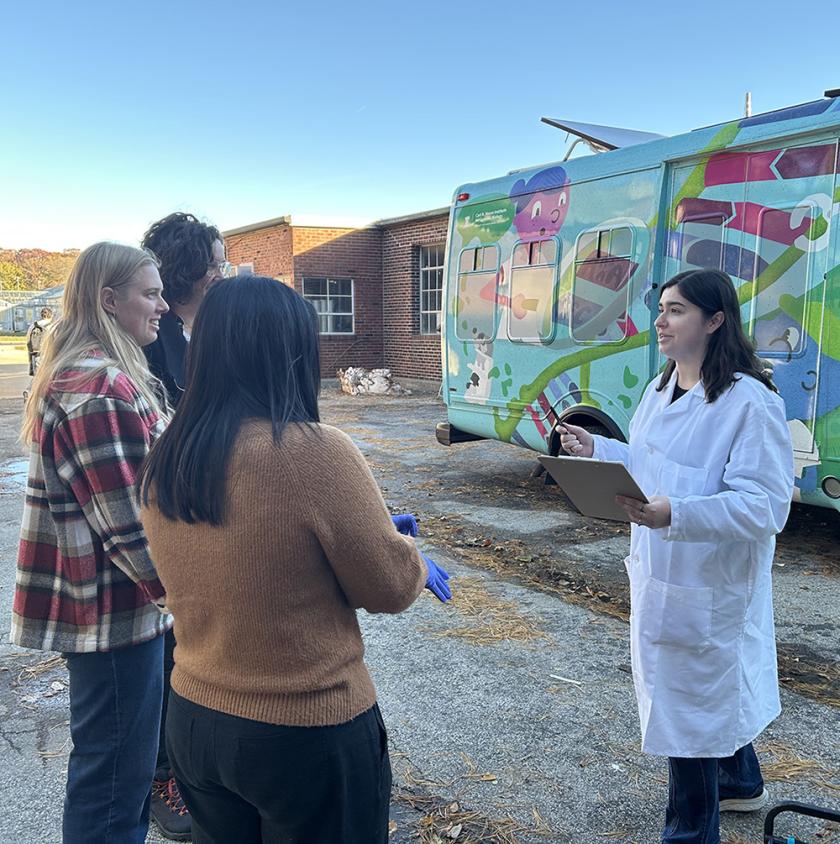
Each fall, an interdisciplinary team of students at the University of Illinois comes together to create an escape room. The class project is the culmination of a collaboration between two courses: Designing Immersive Adventures – Escape Rooms (Theatre 402/Game Studies and Design 490) and Makerspace – Escape Rooms (Informatics 418).
According to THEA 402/GSD 490 instructor Amber Dewey Schultz, teaching assistant professor of immersive and interactive theatre in the College of Fine and Applied Arts, students in her course develop the theme and major obstacles, write the narrative, and design and install the environment. The students also perform as actors in the escape room.
Students in INFO 418 develop the gameplay of the room, turning the story challenges into playable puzzles. To do this, they must consider what information is available to the players and what they need to discover.
"These puzzles are refined through the play testing process, where the students learn more and more about how their players interpret their designs and think through the puzzles. They also fabricate the puzzle components, with some students specializing in 3D modeling, laser cutting, or programming electronics to bring them to life," said Emilie Butt, CU Fab Lab instruction and engagement coordinator, who co-teaches INFO 418 with Duncan Baird, game studies and design instructor.
"The two courses have very different learning outcomes, but the escape room can only happen if all of the students collaborate," said Schultz. "It's a very unusual collaborative course structure—one that we have refined over the last six years."
Daniel Blus, a freshman majoring in political science, registered for THEA 402/GSD 490 because he is pursuing a minor in theatre and enjoys going to escape rooms with his family.
"It was a unique experience to work with students of other majors," he said. "You could see everyone's different areas of expertise show up when we would draft new ideas to make the escape room experience we wanted."
The course instructors select a new client each year, with past clients including the Molecule Maker Lab Institute, Museum of the Grand Prairie, and the Krannert Center for the Performing Arts. This year, they selected the Carl R. Woese Institute for Genomic Biology (IGB), which requested an educational escape room that would be installed in IGB's Mobile Learning Lab.

The students met with IGB early in the semester to understand their goals for the project. In addition to ensuring that the escape room was scientifically accurate, IGB wanted the middle schoolers playing the game to feel like science is fun, interesting, and accessible. Based on those goals, the students developed "Mus-Muscuvirus: an IGB Escape Room."
In this experience, players step into the lab as a team of scientists racing against a rapidly mutating virus that transforms people into mice. The scientists' mission is to track down the original carrier, "Mouse Zero," and use scientific problem-solving to stop the outbreak. They must contain the Mus-Muscuvirus "before the entire world ends up squeaking," Schultz said.
The escape room is scheduled to run from December 1-9 around Champaign-Urbana. At the end of the semester, IGB will take over the escape room and use it as an educational tool for the Mobile Learning Lab's trips around Illinois.
"My favorite part of the class so far has been the installation phase of the escape room," said Blus. "Seeing everyone's hard work finally displayed in the mobile lab was a satisfying and accomplishing moment in my time in the class."
"Through this experience, students are learning how to design for other people, gaining a deeper understanding of the player experience and how it differs from their assumptions, as well as getting a unique opportunity to work with clients very closely," said Butt. "Each student learns something different from this course, because the interdisciplinary nature and collaborations allow each of them to specialize, which is the beauty of hands-on experiential learning opportunities like this."